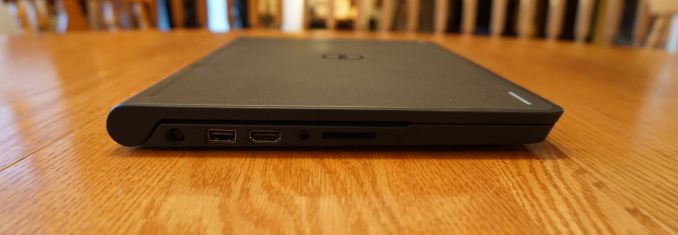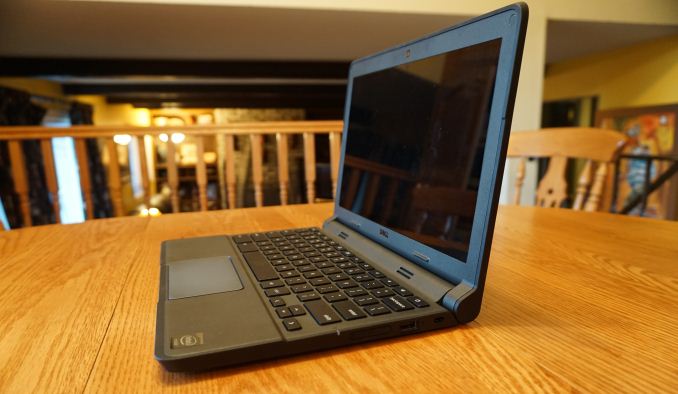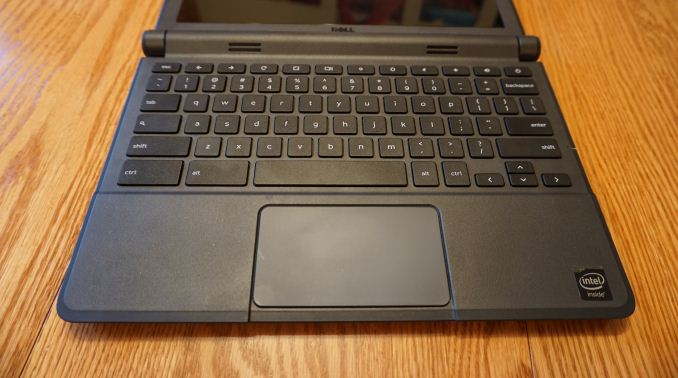The Dell Chromebook 11 Touch Review
by Brandon Chester on May 7, 2015 8:00 AM EST- Posted in
- Laptops
- Chrome OS
- Chromebook

In my view, Chromebooks have gone hand in hand with tablets in eating away the part of the market that was once filled with low quality and low cost netbooks. I think that both tablets and Chromebooks offer a consumer a much better experience than netbooks ever did with their slow hard drives, extremely low resolutions, and inadequate hardware. Personally, I think tablets have a bit of an edge over Chromebooks due to their app ecosystems and typically better quality displays, but both stand above where the netbook was.
The Chromebook is an interesting device though, because I think it's something that both laptop and tablet buyers may consider as an alternative. While the Chromebook was originally criticized by many due to its limited functionality, the capabilities of Google's web apps have increased significantly since that time. Google's online product offerings like Chrome, Docs, Sheets, Slides, and Drive can satisfy the needs of many users, and this has driven growth in the consumer, education, and business sectors alike. The availability of Chromebooks from many different vendors has also contributed to their quick adoption.
One of the manufacturers that has begun to dabble in Chromebooks is Dell, and today's review takes a look at their newest Chromebook. It's the Dell Chromebook 11 Touch. More accurately, it may be called the New Dell Chromebook 11 Touch or the Dell Chromebook 11 (2015) as Dell had offered a previous generation of Chromebooks which were also called the Dell Chromebook 11. This new Chromebook from Dell appears to target a different section of the market than its predecessor, as it sports a new rugged design to protect it from accidents and environmental hazards that it may endure.
| Dell Chromebook 11 Touch (2015) | |
| Processor | Intel Celeron N2840 Dual-core 2.16-2.58GHz HD Graphics 4 EU GPU |
| Connectivity | 2x2 dual-band 802.11ac (Intel 7260NGW) Bluetooth 4.0 (Intel 7260NGW) |
| Memory | 2G or 4GB DDR3L |
| Storage | 16GB eMMC |
| Battery | 3-cell 43Wh |
| I/O | 1 x USB 3.0 1 x USB 2.0 HD webcam Dual array microphone HDMI Headphone/mic jack SD Card reader |
| Dimensions | 11.69" x 8.57" x 0.83" / 297 x 217.7 x 21 mm |
| Display | 11.6" 1366x768 TN LCD with optional capacitive touch |
| Weight | 2.74 lbs. / 1245g (non-touch) 2.91 lbs. / 1320g (touch) |
| Price | $249/$269 for 2GB/4GB non-touch, $329 for 4GB touch |
At $329 most of these specifications are fairly standard for a Chromebook. In fact, you may notice that they are nearly identical to those of Toshiba's Chromebook 2. Apart from some differences in size and mass, and a 1Wh difference in battery capacity, the internal specifications and ports are the same on both Chromebooks. There are two key differences between the two which will likely be the deciding factor for a potential buyer. The first is the rugged build of the Dell, which compares to the more standard tapered plastic shell of the Toshiba. The second is the display, with the Dell Chromebook 11's 1366x768 TN LCD not looking near as appealing on paper as Toshiba's well calibrated 1920x1080 IPS LCD, but including touchscreen functionality. We'll be looking at both of these differences over the course of this review, and they're both important to keep in mind if you're trying to make a decision on what Chromebook to buy.
Design
From this point onward in the review, I'm just going to refer to this laptop as the Dell Chromebook 11 without the word touch on the end. This model is the version with the touch display, but all of my impressions that are unrelated to the touchscreen will also apply to the non-touch model and I don't think it's worth explicitly stating that this is the touch model when it's not necessary. It should also be noted that the non-touch version comes in both 2 and 4 gigabyte RAM configurations for $249 and $269 respectively.
A big part of the Dell Chromebook 11's design is its ruggedness. Dell is touting their MIL-STD testing which means that its durability has been tested against various levels of pressure, temperature, humidity, shocks and vibrations to meet a standard created by the U.S. Department of Defense. For consumers, this basically means that it should survive being knocked against things, having fluids spilled on the keyboard and trackpad, and other forms of daily abuse that other laptops may not stand up to.
While I didn't test its resistance to accidental spills, I did treat the laptop less carefully than I do with my other devices to see how well it would hold up. The rubberized coating that surrounds the edges of the display and all the ports was able to withstand my abuse. Based on that and how the chassis feels, I would say that the Dell Chromebook 11 is good for anyone who works in industries like construction, or who just tends to put their devices through a lot of hardship.
Another interesting design choice on the Dell Chromebook 11 is the cyclindrical hinge which allows the display to be opened up to 180 degrees. This actually has significant implications for durability, as it greatly reduces the risk of the hinge developing weakness or the display being snapped off of the rest of the body due to some force pushing it beyond its maximum angle. From my conversations with teachers at schools that have deployed Chromebooks, damage to them by students often occurs due to some accident or mistreatment causing the hinge to snap. The hinge also serves as the home for a pair of stereo speakers.
Overall I think the Dell Chromebook 11 looks fairly good for a rugged laptop. I'm fairly careful with my devices, and so I lean more toward more traditional plastic or metal designs without additional layers of material to increase durability. That being said, Dell has done a fairly good job of making their Chromebook aesthetically presentable while also making it durable. It's definitely not the most beautiful laptop out there, but its appearance suits its function well, and inspires confidence that it will be able to withstand the types of accidents that would put a large dent in my MacBook.
Other Impressions
Often many parts of a laptop experience are fairly subjective. For example, the feel of a keyboard or a trackpad. Other parts like audio quality can be objectively measured, but I simply lack the equipment to do so. Below you'll find some of my thoughts on these parts of the Dell Chromebook 11, as I think they're important even though they don't fit anywhere else in the review.
The first thing I wanted to discuss is Dell's keyboard. I was actually quite surprised by how nice it feels to type on. The travel distance and amount of force required to press down on the key is similar to that of my MacBook Pro with Retina Display and the Chromebook Pixel. The keys also actually seem less wobbly than my MacBook, and there's a comfortable amount of space between them. The key caps also seem to have a similar soft touch finish to the chassis itself. I'm not sure that I'm a fan of it, but that may just be due to all my other laptops and keyboards using a more glossy plastic finish on the keys which I have become used to.
The next thing to talk about is the trackpad. Unfortunately, this is where things fall apart when it comes to input methods. The tracking itself is normally okay, with no massive amounts of latency. I still feel that while Chrome OS has better default acceleration curves for trackpads than Windows, that it's still not as good as what you get on OS X. The big problem with the trackpad is that the cursor tends to jump around, which makes the act of clicking on a small object or trying to make a small cursor movement extremely frustrating.
The touchscreen in the third method of input on the Dell Chromebook 11. I actually found myself using it more often than I did on the Chromebook Pixel, but this is mostly because of the Dell Chromebook 11's less than optimal trackpad being annoying to use. However, touchscreens are still not extremely useful in Chrome OS, and I don't really think it's worth the $50 price premium that you have to pay compared to the non-touch model.
The last thing I wanted to talk about is the speaker quality. They sound slightly muffled, but they're not that bad as far as laptop speakers go. Having them facing toward you is also much nicer than many other laptops of this size which tend to put them on the sides, or even worse, on the bottom.














46 Comments
View All Comments
nikon133 - Sunday, May 10, 2015 - link
Don't be so quick on judging others, you are not 13, I hope... Anyway. I'll take it with your vast knowledge, you are shooting your DSLR in JPG. Personally I think it is a bit of waste, but I'm not judging - see? Being mature. Or are you using something like Polarr on your Chromebook? Presuming that Polarr can to RAW off-line - most hotels I've been in, some Hiltons and Novotels included - had quite abysmal, yet extremely expensive Internet - can you easily export library from your Chromebook and import it in Lightroom with all the edits (you might have done on Chromebook) preserved? Or do you use CB exclusively for all your photo needs?And... you are comparing 2015 Chromebooks with machines introduced in 2007 and not significantly upgraded in their lifetime? That's a bit unrealistic. I said "at least I could dump my photos..." to underline my disagreement with this minimal storage trend on machines that aim to replace traditional laptop for some/many, I didn't say that I would be using netbook today. I did say that for my usage scenario something like 128GB Surface 3 is better, and I think that statement is quite solid. Otherwise, I agree there is no need to drag heavy Windows laptop - that is why we have all sort on ultrabooks, MBAs, convertibles. If I am aware of that, with all my lack of hardware knowledge, you must be too, for sure.
nikon133 - Sunday, May 10, 2015 - link
Nope.I'm a bit of camera freak. I shot in RAW, and my current camera does about 20MB photo size. I usually carry with me two 32GB SD cards, and one 16GB for backup... though so far I never filled up 64GB, but I did come close to that. Realistically, I'm usually between 32 and 48GB of RAM images.
Good luck with that on 16GB storage Chromebook.
Even if I could backup to another SD card via built-in storage... really? Copying 32+ GB to laptop's SSD and then back to another SD card makes more sense than dumping it to laptop's storage and leaving it there? In which universe..?
I don't understand some of you folks. Just because your favourite company made something, suddenly it is perfectly OK do downgrade dramatically and workout some funny workarounds in order to cope with severe limitations. Personally, I'm OK to go down from 500+ GB HDD to 256GB SSD... or even 128GB SSD... but down to 16GB? Where do I put my movies/TV/digital comics I like to carry with me on trips?
Beside all that... I like having Adobe Lightroom on my travel machine, in case I want to export a few photos to JPG, for whatever reason I might have (usually wife wanting to email someone from her vast list of friends and relatives). It doesn't have to be up to speed, just a few photos will get munched even on 4C Atom, as long as it runs Windows (or OSX). On Chromebook, a bit harder.
Finally... both my wife and I need access to MS Office every now and then, even on vacations. Especially her. She is working on local Uni, her group always have a few papers waiting to be published in different scientific magazines, and very often they get returned for some corrections. Being able to open/edit/resend might not be a must - in most cases it can wait until we are back - but bonus it sure is.
And really... "hot and heavy Windows laptop with a short battery life"? With abundance of ultrabooks and tablets with decent battery life, low weight and good performance, that really isn't argument anymore. Even my wife's 2011 13" Vaio S could run 6 hours and carried i3, 4GB RAM /500GB HDD and was something around 1.4KG without extended battery. Yes, there is a price-tag... but if cheap machine doesn't do the job for me, I'll pay it gladly.
Don't judge everyone by your usage scenarios. If Chromebook does indeed work for you, well, power to you; and savings. But one shoe doesn't fit all. Never did, never will. I didn't say that my reasoning is universal, but it is my reasoning.
jabber - Monday, May 11, 2015 - link
You do know that no one really wants to see your holiday pics whether shot in JPEG or converted and edited from RAW? They really don't. If they do they are just being polite.You are putting in too much effort for an audience that isn't there.
nikon133 - Monday, May 11, 2015 - link
Well... let's put it this way.No one wants to watch me playing games - and I'm still playing them.
No one wants to watch me watching Game of Thrones, but what do you know - I still watch it.
There are things I do for myself, because I'm enjoying them, not because I want to impress anyone. Photos are my hobby, and I'm getting a blast from making and editing them. Effort I'm putting in is something that relaxes me, so the most important audience - myself - is there. It also gives me reason to be active and spend more time outdoors - and God knows, working in the office, driving car to and from work and spending additional time behind gaming machine(s), I could use much more outdoor time than what I'm giving myself :)
I'm never showing my photos to anyone by default, if anyone asks to see my last travel/vacation, they get a link to small gallery of 20-30 selected photos (out of 1000+) sitting on OneDrive or FB.
I don't really do vacation photos - as in, me and my family on the beach. My wife does a lot of conferences and visits/co-ops with Universities around the world, and I travel with her whenever I can. Places like Prague, Budapest, Mainz, Lyon... are great opportunities for camera action, and decent modern DSLR really gives great tools to play with... RAW being one of them. Having DSLR and not using RAW is a criminal act, really ;)
nikon133 - Monday, May 11, 2015 - link
And all that being said, fact remains that laptop with 16GB of storage just doesn't hold water for me. Back in early 2000, my Toshiba Satellite 1000 had 15GB HDD, and it was barely enough... but that was back then. My main camera was film, my digital camera was 2MP Canon A40, and everything else digital was much smaller than today.Today, a decent Android tablet - or even iPad - with keyboard dock and access to large apps library would probably be much better travel companion to me. With additional benefit of being convertible.
der - Thursday, May 7, 2015 - link
Dell swagbook 11.der - Thursday, May 7, 2015 - link
The Toshiba one even can go over 1080p as max resolution, something like 2048 by 1152. It-s a win-win!Uplink10 - Thursday, May 7, 2015 - link
"Starting at $249 for 2GB of RAM"You can get a Baytrail laptop for that price or similar with 4GB of RAM, 500 GB HDD, better BIOS/UEFI... Can you even reinstall OS (install proper Linux) or upgrade hardware or disable/enable devices like in a normal computer in a normal BIOS/UEFI?
SM123456 - Thursday, May 7, 2015 - link
That must be Canadian dollars - Chromebooks with that spec are $179 now.As far as Windows machines like the HP Stream 11 are concerned, they are half the speed as identically spec'ed Chromebooks according to independent benchmarks like Kraken and Octane, which measure all round browser performance - and that is just running a browser. Running legacy Windows applications on Windows netbook class devices like the HP Stream 11 will be a whoile lot slower. It is all down to the full fat bloated nature of the Windows OS compared to the lean mean ChromeOS - shoehorning Windows into these low spec devices makes for a painfully slow experience, whereas ChromeOS is fast and responsive because it uses a server in the cloud to do the heavy lifting, and the local OS is very lightweight.
By the way, here is a Chromebook "running" Adobe Premiere Pro, Photoshop cc, Excel, AutoDesk 3DS Max, AutoCAD 3D, and SolidWorks on a server faster and smoother than a hot and heavy $1700 high end CAD laptop with a 2.5 hour battery life can manage, and still do it with 11 hours battery life.
https://www.youtube.com/watch?v=RbP5jsoyxOY
Uplink10 - Thursday, May 7, 2015 - link
That Chromebook is runing a client which is connected to a Virtual Machine, meaning it is not actually doing anything other than displaying screen of VM, of course it is fast if processing is not done on a Chromebook but in a VM somwhere else, performance needed is the same as displaying a video or runing RDP or VNC client. Where did you get the idea Chromebook is faster than a $1700 workstation?